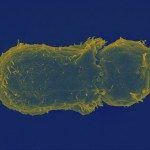Link to Pubmed [PMID] – 21458997
Trends Microbiol. 2011 Jun;19(6):257-62
The recent finding that the human T-cell leukemia virus type 1 (HTLV-1) encases itself in a carbohydrate-rich adhesive extracellular ‘cocoon’, which enables its efficient and protected transfer between cells, unveiled a new infectious entity and a novel mechanism of viral transmission. These HTLV-1 structures are observed at the surface of T cells from HTLV-1-infected patients and are reminiscent of bacterial biofilms. The virus controls the synthesis of the matrix, which surrounds the virions and attaches them to the T cell surface. We propose that, similar to bacterial biofilms, viral biofilms could represent ‘viral communities’ with enhanced infectious capacity and improved spread compared with ‘free’ viral particles, and might constitute a key reservoir for chronic infections.

